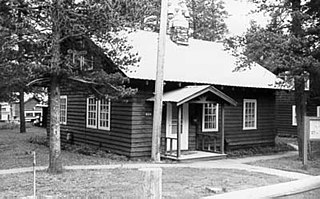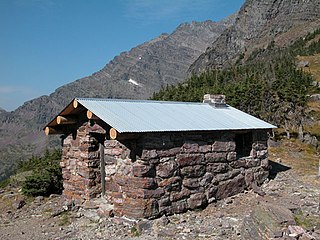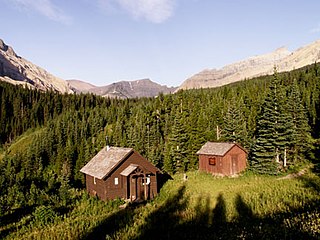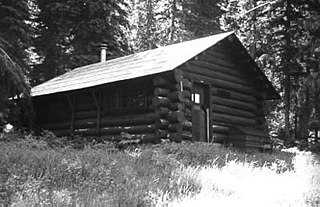
Yosemite National Park is a national park in California. It is bordered on the southeast by Sierra National Forest and on the northwest by Stanislaus National Forest. The park is managed by the National Park Service and covers 759,620 acres in four counties – centered in Tuolumne and Mariposa, extending north and east to Mono and south to Madera. Designated a World Heritage Site in 1984, Yosemite is internationally recognized for its granite cliffs, waterfalls, clear streams, giant sequoia groves, lakes, mountains, meadows, glaciers, and biological diversity. Almost 95 percent of the park is designated wilderness. Yosemite is one of the largest and least fragmented habitat blocks in the Sierra Nevada.

Yosemite Valley is a glacial valley in Yosemite National Park in the western Sierra Nevada mountains of Central California, United States. The valley is about 7.5 mi (12.1 km) long and 3,000–3,500 ft (910–1,070 m) deep, surrounded by high granite summits such as Half Dome and El Capitan, and densely forested with pines. The valley is drained by the Merced River, and a multitude of streams and waterfalls flow into it, including Tenaya, Illilouette, Yosemite and Bridalveil Creeks. Yosemite Falls is the highest waterfall in North America and is a big attraction, especially in the spring, when the water flow is at its peak. The valley is renowned for its natural environment and is regarded as the centerpiece of Yosemite National Park.

Herbert Maier was an American architect and public administrator, most notable as an architect for his work at Yosemite, Grand Canyon and Yellowstone National Parks. Maier, as a consultant to the National Park Service, designed four trailside museums in Yellowstone, three of which survive as National Historic Landmarks. Maier played a significant role in the Park Service's use of the National Park Service Rustic style of architecture in western national parks.

The Fishing Bridge Museum is one of a series of "trailside museums" in Yellowstone National Park, Wyoming, United States, designed by architect Herbert Maier in a style that has become known as National Park Service Rustic. It is one of three parts of a 1987-declared National Historic Landmark, the Norris, Madison, and Fishing Bridge Museums. It was not listed separately on the National Register of Historic Places as the other two were. Built in 1931, the Fishing Bridge Museum is the largest in the series, and is used as a small visitor center. The museum displays stuffed mounts of birds and animals found in Yellowstone Park.

The Norris, Madison, and Fishing Bridge Museums are three "trailside museums" within Yellowstone National Park in the western United States. Built in 1929 to designs by Herbert Maier, they are preeminent early examples of the National Park Service Rustic style of architecture, and served as models for the construction of park buildings elsewhere in the park system in the 1930s. They were collectively designated a National Historic Landmark in 1987.

The East Glacier Ranger Station, east of Glacier National Park, is characteristic of park buildings constructed in the 1920s and 1930s. It was designed by Daniel Ray Hull of the National Park Service Office of Plans, as a frame building compatible in style with the prevailing National Park Service Rustic style. It is the center of a group of related buildings, including several residential structures.

The Cut Bank Ranger Station in Glacier National Park was one of the first buildings built in Glacier by the National Park Service. Built in 1917, the design is in keeping with park hotel structures built by the Great Northern Railway in a Swiss chalet style that predated the fully developed National Park Service Rustic style.

The Many Glacier Campground Camptender's Cabin in Glacier National Park is an example of the National Park Service Rustic style. Built in 1934, the small cabin is significant for its association with park visitation patterns, auto camping, and NPS rustic architecture.

The Gunsight Pass Shelter in Glacier National Park is a rustic stone building near the treeline. The one-room shelter is equipped with a woodstove. Work began on the shelter in September 1931 and was complete in June 1932 to a design by the National Park Service Landscape Division. The design was inspired by similar cabins built by the Appalachian Mountain Club in the White Mountains of New Hampshire. The shelter is located on the South Loop Trail, itself listed on the National Register of Historic Places.

The Ford Creek Patrol Cabin in Glacier National Park was built in 1928. The National Park Service Rustic log structure was a significant resource both architecturally and historically as a network of shelters, approx. one day's travel apart, for patrolling backcountry rangers.

The Apgar Fire Lookout in Glacier National Park is significant as one of a chain of fire lookout posts within the park. The low two-story frame-construction structure with a pyramidal roof was built in 1929. The design originated with the U.S. Forest Service and has been modified and re-used by the Forest Service and the National Park Service in a variety of contexts.

The Swiftcurrent Fire Lookout in Glacier National Park is significant as one of a chain of staffed fire lookout posts within the park. The low two-story timber-construction structure with a gabled roof was built in 1936. Its detailing is reminiscent of the Swiss Chalet style of the nearby Many Glacier Hotel. The design is modified from standard U.S. Forest Service plans. The Swiftcurrent lookout was listed on the National Register of Historic Places in 1986, and it is also listed on the National Historic Lookout Register.

The Slide Lake-Otatso Creek Patrol Cabin and Woodshed in Glacier National Park are a small group of rustic buildings in the park's backcountry. Built in 1936, the patrol cabin is a frame building, unlike the more typical log patrol cabins found throughout the park. The similar woodshed is nearby. The cabin's proximity to the Alpine-themed Many Glacier Hotel may have influenced the decorative detailing, which is unique in Glacier. The only other frame patrol cabin is the Fielding Cabin, in the southern part of the park. The cabin was completely reconstructed in the 1980s "to thwart a particularly aggressive pack rat population". The buildings are located along Otatso Creek, 1.25 miles (2.01 km) downstream from Slide Lake.

The Logan Creek Patrol Cabin in Glacier National Park is a rustic backcountry log cabin. Built in 1925, the cabin has a single room. It is unusual among Glacier's patrol cabins in lacking a covered porch to offer sheltered firewood storage and protection for the entrance.

The Tuolumne Meadows Ranger Station and Comfort Stations are examples of National Park Service Rustic design in Yosemite National Park. They are within the Tuolumne Meadows Historic District at Tuolumne Meadows. The ranger station was built in 1924 using peeled log construction. The ranger station doubled as the park entrance station for the Tioga Road. Its function was partly superseded by a newer structure in 1936, using larger quantities of stonework.

The Crane Flat Fire Lookout in Yosemite National Park was built in 1931. An example of the National Park Service Rustic style, the lookout is a two-story structure with a lower storage or garage level and an upper observation level, with an overhanging roof. Design work was carried out by the National Park Service Landscape Division.

The Comfort Station is a historic "sanitary" on Blue Hill Avenue in Milton, Massachusetts. It is located in the Blue Hills Reservation, managed by the Massachusetts Department of Conservation and Recreation.

Curry Village is a resort in Mariposa County, California in Yosemite National Park within the Yosemite Valley.

The McGurk Cabin in Yosemite National Park was the seasonal home of Yosemite cattleman Jack McGurk from 1895 to 1897. Located on the edge of McGurk's Meadow, just to the north of the Glacier Point Road, the cabin was used by a series of owners beginning with Hugh Davanay, from whom McGurk bought the property in 1895. McGurk was evicted by the Army in 1897 after a dispute over title to the land. The log cabin is a one-room structure, about 14 feet (4.3 m) square, with saddle-notched peeled lodgepole pine logs. The only opening is a low door on the south side. The cabin was stabilized in 1958 by Sierra Club volunteers. It is one of the few structures left in the park that remain from the pre-park era.
Architects of the National Park Service are the architects and landscape architects who were employed by the National Park Service (NPS) starting in 1918 to design buildings, structures, roads, trails and other features in the United States National Parks. Many of their works are listed on the National Register of Historic Places, and a number have also been designated as National Historic Landmarks.




















